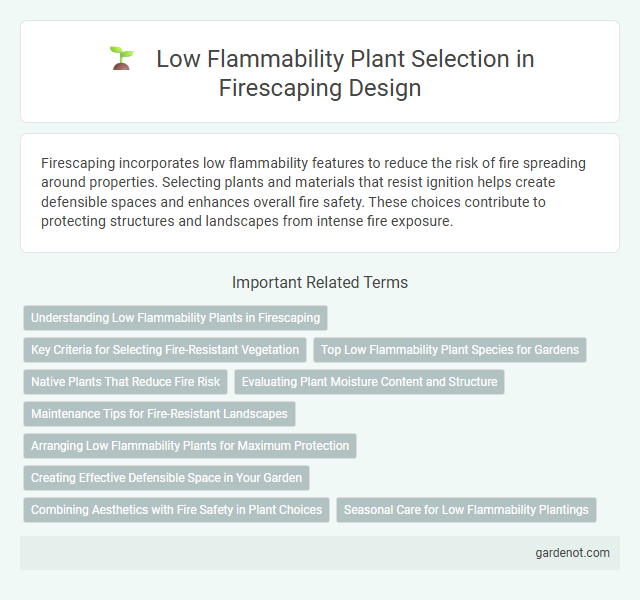Firescaping incorporates low flammability features to reduce the risk of fire spreading around properties. Selecting plants and materials that resist ignition helps create defensible spaces and enhances overall fire safety. These choices contribute to protecting structures and landscapes from intense fire exposure.
Understanding Low Flammability Plants in Firescaping
Low flammability plants in firescaping are selected for their high moisture content, minimal resin, and low volatile oils, which significantly reduce fire spread. These species, such as succulents, deciduous shrubs, and certain fire-resistant trees, help create defensible spaces by slowing flames and lowering radiant heat. Understanding their growth patterns and maintenance needs ensures effective landscape design and enhances property protection against wildfires.
Key Criteria for Selecting Fire-Resistant Vegetation
Selecting fire-resistant vegetation requires evaluating low flammability characteristics such as high moisture content, minimal volatile oils, and slow ignition properties. Plants with thick, fleshy leaves or high salt concentrations tend to resist burning and reduce fire spread. Prioritizing species native to fire-prone areas ensures better adaptation to local conditions and enhances overall landscape resilience.
Top Low Flammability Plant Species for Gardens
Top low flammability plant species for gardens include manzanita (Arctostaphylos spp.), Oregon grape (Mahonia spp.), and California lilac (Ceanothus spp.), all known for their high moisture content and minimal resin production that reduce fire risk. Succulents like agave (Agave spp.) and aloe vera (Aloe spp.) possess thick, water-rich leaves that resist ignition and slow fire spread. Incorporating these drought-tolerant, fire-resistant species enhances landscape resilience while maintaining aesthetic appeal.
Native Plants That Reduce Fire Risk
Native plants with low flammability significantly reduce fire risk by containing higher moisture content and minimal volatile oils. Species such as manzanita, California lilac, and ceanothus are excellent choices for firescaping due to their fire-resistant properties. Integrating these native plants into landscaping creates natural firebreaks and enhances overall vegetation resilience in wildfire-prone areas.
Evaluating Plant Moisture Content and Structure
Evaluating plant moisture content and structure is crucial for firescaping, as higher moisture levels in leaves and stems significantly reduce flammability risk. Plants with succulent, fleshy tissues or dense, compact arrangements tend to retain moisture longer, limiting ignition potential during wildfire events. Optimal low-flammability landscaping integrates species with high internal water content and robust structural characteristics to enhance fire resistance.
Maintenance Tips for Fire-Resistant Landscapes
Pruning dead branches regularly reduces fuel for potential fires and maintains plant health in fire-resistant landscapes. Applying mulch made from non-flammable materials helps retain soil moisture and prevents sparks from reaching plant roots. Installing drip irrigation systems ensures consistent watering, minimizing drought stress and lowering flammability risk in low-flammability gardens.
Arranging Low Flammability Plants for Maximum Protection
Strategically arranging low flammability plants such as succulents, lavender, and yarrow forms natural firebreaks that slow fire spread and reduce heat intensity. Grouping these drought-tolerant species near structures and along property boundaries creates defensible spaces that enhance overall fire resilience. Consistent maintenance, including pruning and removing dead material, ensures these plants retain their fire-resistant properties and maximize protection in firescaping designs.
Creating Effective Defensible Space in Your Garden
Selecting low flammability plants such as succulents, lavender, and California lilac significantly reduces fire risk, enhancing the effectiveness of your garden's defensible space. Proper spacing between vegetation and using hardscape elements like gravel or stone pathways further inhibits fire spread and provides safe zones for firefighters. Incorporating these fire-resistant landscaping strategies creates a resilient barrier that protects your property and increases overall wildfire preparedness.
Combining Aesthetics with Fire Safety in Plant Choices
Low flammability plants such as succulents, lavender, and California lilac offer a balance between fire safety and visual appeal, significantly reducing ignition risks in firescaping. Incorporating drought-tolerant, low-resin species helps create defensible space that resists flame spread while maintaining lush, attractive landscaping. Strategic plant selection enhances property protection without compromising the aesthetic quality of outdoor environments.
Seasonal Care for Low Flammability Plantings
Seasonal care for low flammability plantings involves regular pruning, debris removal, and timely irrigation to maintain plant health and reduce combustible material buildup. Selecting drought-tolerant, fire-resistant species that shed minimal leaves helps minimize fuel loads throughout the year. Proper mulching and monitoring for pest or disease outbreaks ensure the plants remain vigorous and effective as a firebreak.
Low flammability feature Infographic

 gardenot.com
gardenot.com